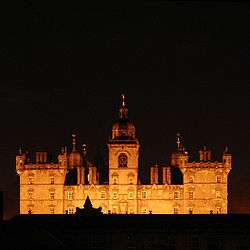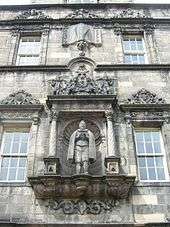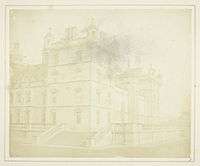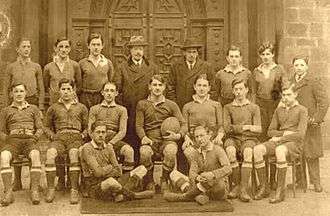George Heriot's School
 | |
| Motto |
"Impendo" ("I Distribute Chearfullie [sic]") |
|---|---|
| Established | 1628 (as George Heriot's Hospital) |
| Type | Independent day school[1] |
| Principal | Mr Cameron Wyllie |
| Head of the Senior School | Mr Robert Dickson |
| Head of the Junior School | Mrs Lesley Franklin |
| Chairman of Governors | Mr Michael Gilbert |
| Founder | George Heriot |
| Location |
Lauriston Place Old Town, Edinburgh EH3 9EQ Scotland Coordinates: 55°56′45″N 3°11′40″W / 55.945918°N 3.194317°W |
| Staff | 155 teaching, c.80 non-teaching |
| Students | c.1600 |
| Gender | Coeducational |
| Ages | 3–18 |
| Houses | Castle, Greyfriars, Lauriston, Raeburn |
| Colours | Navy Blue, White |
| Publication | The Herioter |
| School song | "The Merry Month of June" |
| Website |
www |
George Heriot's School is a Scottish independent primary and secondary school on Lauriston Place in the Old Town of Edinburgh, Scotland, with over 1600 pupils, 155 teaching staff and 80 non-teaching staff.[2] It was established in 1628 as George Heriot's Hospital, by bequest of the royal goldsmith George Heriot,[3] and opened in 1659.
Architecture
.jpg)

The main building of the school is notable for its renaissance architecture, the work of William Wallace, until his death in 1631.[4] He was succeeded as master mason by William Aytoun, who was succeeded in turn by John Mylne.[5][6] In 1676, Sir William Bruce drew up plans for the completion of Heriot's Hospital. His design, for the central tower of the north façade, was eventually executed in 1693.[7]
The school is a turreted building surrounding a large quadrangle, and built out of sandstone.[8] The foundation stone is inscribed with the date 1628. The intricate decoration above each window is unique (with one paired exception - those on the ground floor either side of the now redundant central turret on the west side of the building). A statue of the founder can be found in a niche on the north side of the quadrangle.
The main building was the first large building to be constructed outside the Edinburgh city walls. It sits next to Greyfriars Kirk, built in 1620, in open grounds overlooked by Edinburgh Castle directly to the north. Parts of the seventeenth-century city wall (the Telfer Wall) serve as the walls of the school grounds. When built the building's front facade faced the entrance on the Grassmarket. It was originally the only facade fronted in fine ashlar stone, the others being harled rubble, but in 1833 the three rubble facades were refaced in Craigleith ashlar stone. This was done as the other facades had become more visible with the new entrance on Lauriston Place. The refacing work was handled by Alexander Black the then Superintendent of Works for the school, who later designed the first Heriot's free schools around the city.
The north gate onto Lauriston Place is by William Henry Playfair and dates from 1829. The chapel interior is by James Gillespie Graham (1837) who may have been assisted by Pugin. The primary school building was designed by Alexander Black (architect) in 1838. The science block is by John Chesser (architect) and dates from 1887.[7]
The grounds contain a selection of other buildings of varying age; these include a swimming pool and a granite war memorial, dedicated to the school's former pupils and teachers who died in World War I and World War II.
History

On his death in 1624, George Heriot left around 25,000 Pound Scots – equivalent to several tens of millions today – to found a "hospital" (then the name for this kind of charitable school) to care for the "puir, faitherless bairns" (Scots: poor, fatherless children) of Edinburgh.
The construction of Heriot's Hospital (as it was first called) was begun in 1628, just outside the city walls of Edinburgh. It was completed just in time to be occupied by Oliver Cromwell's English forces during the invasion of Scotland during the Third English Civil War; the building was used as a barracks, with horses stabled in the chapel.
The hospital opened in 1659, with thirty sickly children in residence; its finances grew, and it took in other pupils in addition to the orphans for whom it was intended. In the 1880s, it began to charge fees; however, to this day it serves its charitable object, providing free education to fatherless children, referred to as "foundationers". In 1846 there was an insurrection in the hospital and fifty-two boys were dismissed.[9]

In 1837 the school founded ten "free schools" in Edinburgh, educating several thousand pupils across the city; these were closed in 1885. One of them, with a copy of several of the features of the original Lauriston Place building, is at the east end of the Cowgate (now serving as a Salvation Army hostel).
The school also provided funds for the establishment of an institution which later merged with the Watt Institution (named after James Watt) in the 1870s to form Heriot-Watt College, a technical college that became Heriot-Watt University in 1966.
In 1979 it became co-educational with the arrival of the first girls, and now has around 1600 pupils. Today, the school is Edinburgh's best performing school by Higher exam results[10] with leavers (in 2014) attending the country's most selective and prestigious universities including St Andrews (31), Glasgow (26) and Edinburgh (14) in Scotland and Oxford (2), Cambridge (4), Bristol (4) and King's College London (3) in England.[11]

Headmasters

Chronological list of the headmasters of the school, the year given being the one in which they took office.[12]
- 1659 James Lawson
- 1664 David Davidsone
- 1669 David Browne
- 1670 William Smeaton
- 1673 Harry Moresone
- 1699 James Buchan
- 1702 John Watson
- 1720 David Chrystie
- 1734 William Matheson
- 1735 John Hunter
- 1741 William Halieburton
- 1741 John Henderson
- 1757 James Colvill
- 1769 George Watson
- 1773 William Hay
- 1782 Thomas Thomson
- 1792 David Cruikshank
- 1794 James Maxwell Cockburn
- 1795 George Irvine
- 1805 John Somerville
- 1816 John Christison
- 1825 James Boyd
- 1829 Hector Holme
- 1839 William Steven
- 1844 James Fairburn
- 1854 Frederick W. Bedford
- 1880 David Lowe
- 1908 John Brown Clark
- 1926 William Gentle
- 1942 William Carnon
- 1947 William Dewar
- 1970 Allan McDonald
- 1983 Keith Pearson
- 1997 Alistair Hector
Thereafter, the title of Headmaster was changed to that of Principal.
- 2014 (January) Gareth Doodes[13]
- 2014 (September) Cameron Wyllie (Acting)
- 2014 (December) Cameron Wyllie[14]
Houses
Pupils at the school belong to one of four houses:
- Lauriston (green, after the school's address, Lauriston Place
- Greyfriars (white, named after the adjacent Greyfriars Kirk)
- Raeburn (red, after a famous former pupil, Henry Raeburn)
- Castle (blue, after Edinburgh Castle to the north)
Extra-curricular activities
George Heriot's School has a wide range of extra-curricular activities in which pupils participate.
- The pipe band is headed by Pipe Major Willie MacIntyre, and around 120 pupils take tuition of some kind.[15]
- The George Heriot's School Combined Cadet Force is headed by Colonel Bain, and around 60 pupils participate in weekly activities and summer camps.
Notable alumni

- Nick Abbot (born 1960), talk radio presenter
- Tasmina Ahmed-Sheikh, SNP politician
- James Aitken, aka "John the Painter" (1752–1777), terrorist[16]
- Ian Bairnson (born 1953), musician, member of Pilot and The Alan Parsons Project
- Hippolyte Blanc (1844-1917), architect[17]
- George Alexander Carse (1880-1950) physicist (dux in 1898)
- J. W. S. Cassels (born 1922), mathematician
- Bruce Douglas (born 1980), Rugby Union player
- Emun Elliott, actor
- Gavin Esler (born 1953), television journalist and presenter of Newsnight
- Colonel Clive Fairweather (1944-2012), 2nd in command of the SAS during the Iranian Embassy siege.[18]
- Professor Adam Watt, Head of Modern Languages at University of Exeter.[19]
- * Robert John (Robin) Ferrier (1932–2013), carbohydrate chemist
- Archie Forbes CBE (1913-1999), Colonial administrator
- Graham Forbes CBE (1951-), Provost of St Mary's Cathedral, Edinburgh
- John Borthwick Gilchrist (1759–1841), Indologist
- Professor Sir Abraham Goldberg KB MD DSc FRCP FRSE (1923–2007), Emeritus Regius Professor of the Practice of Medicine, University of Glasgow[20]
- Hector Bransby Gooderham (1901–1977), priest of the Scottish Episcopal Church
- Mark Goodier (born 1961), Radio One disc jockey
- Mike Heron (born 1942), musician, formerly of the Incredible String Band
- Norman Irons, former Lord Provost of Edinburgh
- Andy Irvine (born 1951), Rugby Union player
- Gordon Keddie, (born 1944), Reformed Presbyterian minister and theologian
- Roy Kinnear (1934–1988), actor
- Hyman Levy (1889 – 1975), Scottish philosopher, mathematician, political activist and fellow of the Royal Society of Edinburgh
- James Mackay, Baron Mackay of Clashfern (born 1927), Advocate and former Lord Chancellor
- David McLetchie (1952 - 2013), former leader of the Scottish Conservative and Unionist Party
- Sir Harry (Work) Melville FRSE (1908–2000), polymer chemist and administrator[21]
- Iain Macwhirter, journalist and Rector of the University of Edinburgh
- Iain Milne (born 1956), Rugby Union player
- Kenny Milne (born 1961), Rugby Union player
- Sir Andrew Hunter Arbuthnot Murray (1903–1977), former Lord Provost of Edinburgh
- Doug Naysmith (born 1941), Labour politician and former MP for Bristol North West
- Gordon Prentice (born 1951), Labour politician and former MP for Pendle
- Henry Raeburn (1756–1823), painter
- Ian Richardson (1934–2007), actor
- Gordon Ross, Rugby Union player
- Ken Scotland, Rugby Union internationalist[22][23]
- Mike Scott (born 1958), musician and composer, founder of The Waterboys
- Brian Smith (bishop) (born 1943), Bishop of Edinburgh (Scottish Episcopal Church) 2001-11
- Tony Stone (born 1979), entrepreneur and founder of Scottish food maker Stoats Porridge Bars
- David Stuart McGregor (1895-1918), Scottish recipient of the Victoria Cross
- Ken Stott (born 1955), actor
- Polly Swann (born 1988), Member of the GB Rowing Team, and Rowing World Champion
- Bryan Swanson (born 1980), Sky Sports chief reporter
- Nigel Tranter (1909–2000), historical novelist
- Robert Urquhart (1921–1995), actor
- Douglas Walker (born 1973), sprinter
- Stephen Woolman, Lord Woolman, Senator of the College of Justice
- Paul Young (born 1944), actor
References
- ↑ "George Heriot's School - Edinburgh City". Scottish Schools Online. Retrieved 13 May 2013.
- ↑ "Facilities and Staff". George Heriot's School. Retrieved 13 May 2013.
- ↑ "George Heriot and his Bequest". George Heriot's School. Retrieved 13 May 2013.
- ↑ Colvin, Howard (1978). A Biographical Dictionary of British Architects 1600-1840. John Murray.
- ↑ Colvin, Howard (1978). A Biographical Dictionary of British Architects 1600-1840. John Murray. pp. 569–70.
- ↑ McWilliam, Colin; Walker, David; Gifford, John (1984). The Buildings of Scotland: Edinburgh. Penguin. pp. 179–82.
- 1 2 McWilliam, Colin; Walker, David; Gifford, John (1984). The Buildings of Scotland: Edinburgh. Penguin. p. 180.
- ↑ "Architectural Detail and Tower". George Heriot's School. Retrieved 13 May 2013.
- ↑ Gilbert, William Matthews (1901). Edinburgh in the Nineteenth Century. J. & R. Allan.
- ↑ Private schools up to mark with best ever exam results
- ↑ Higher Education Destinations of Leavers 2014
- ↑ Jinglin' Geordie's Legacy, 2009, Brain Lockhart, ISBN 978-1862322578 page 333
- ↑ Appointment of Principal. "George Heriot's Schoo". Retrieved 13 May 2013.
- ↑ Appointment of Principal. "George Heriot's School" (PDF). Retrieved 16 December 2014.
- ↑ "The Royal Scottish Pipe Band Association".
- ↑ Holgate, Andrew (15 February 2005). "Biography: John The Painter by Jessica Warner". London: The Times Online. Retrieved 22 December 2008.
- ↑ "Hippolyte Jean Blanc". Retrieved 2014-03-09.
- ↑ "Obituaries:Colonel Clive Fairweather". Daily Telegraph. 15 October 2012. Retrieved 15 October 2012.
- ↑ "Biography:Professor Adam Watt". Exeter University. 2013. Retrieved 15 October 2013.
- ↑ Professor Kenneth McColl, Professor Henry Dargie (19 May 2008) [originally published (sans commentary by McColl & Dargie) in The Herald 9 October 2007]. "Obituary - Professor Sir Abraham Goldberg - Physician, scientist and academic" (PDF). Royal Society of Edinburgh. Retrieved 30 November 2008.
- ↑ Gowenlock, Brian G; B J Aylett; J C Bevington; D C Bradley; T S West; W P Richards; A G Hector (18 August 2004). "Obituary - Sir Harry (Work) Melville" (PDF). Royal Society of Edinburgh. Retrieved 30 Nov 2008.
- ↑ "The Official Website of The British & Irish Lions - History - Ken Scotland". British and Irish Lions. Retrieved 30 Nov 2008.
- ↑ Connor, Jeff (22 February 2001). Giants of Scottish Rugby. Edinburgh, Scotland: Mainstream Publishing. ISBN 1-84018-478-7.
External links
- George Heriot's School
- George Heriot's School page on Scottish Schools Online
- Profile on the Independent Schools Council website